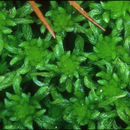Comments
provided by eFloras
Sporophytes of Sphagnum mendocinum are uncommon. Although the unique branch leaf porosity makes it unmistakable microscopically, it may be confused with other species in the field. It is unusual ecologically in that it seems to overlap both the carpet- and lawn-forming habits—in other words it seems intermediate between S. recurvum and S. cuspidatum, in the broad sense. Among the species that it overlaps floristically, it is more robust and darker colored than S. pacificum. The latter also has an apiculate stem leaf compared to the more or less obtuse stem leaves of S. mendocinum. The more wet-growing S. majus var. majus and S. majus var. norvegicum, with which it slightly overlaps in habitat, have branch leaves that are strongly elongated at the distal branch ends whereas those of S. mendocinum are not. See also discussion under 40. S. obtusum. Sexual condition and spore characters are taken from from H. A. Crum (1984).
- license
- cc-by-nc-sa-3.0
- copyright
- Missouri Botanical Garden, 4344 Shaw Boulevard, St. Louis, MO, 63110 USA
Description
provided by eFloras
Plants moderately robust and lax; terminal bud somewhat enlarged; yellow-green to light brownish green. Stems yellow-green; superficial cortex of 1-2 layers of moderately enlarged cells. Stem leaves broadly oblong-triangular, 1.2-1.5 mm; mostly appressed to stem; apex obtuse; hyaline cells narrow, usually nonseptate, efibrillose and aporose on convex surface near apex, on concave surface usually efibrillose with irregular pores along commissures in distal portion of leaf. Branches with loosely imbricate leaves; often 5-ranked; leaves little to somewhat elongated at distal end. Branch fascicles with 2 spreading and 2-3 pendent branches. Branch stems green, with cortical cells in 1 layer with conspicuous necks. Branch leaves ovate, ovate-lanceolate to lanceolate; 2-3.5 mm; flat and undulate at margins and recurved at apex when dry; straight; margins entire; hyaline cells on concave surface with very numerous, small ringed or unringed pores along the commissures, 5-12 in distal portion of leaf and 20-27 in proximal portion, convex surface with 5-15 pores per cell in distal portion of leaf and 14-21 in proximal portion, pores usually without a ring; chlorophyllous cells triangular to trapezoidal in transverse section and exposed slightly on concave surface. Sexual condition dioicous. Spores ca. 30 µm; very slightly roughened.
- license
- cc-by-nc-sa-3.0
- copyright
- Missouri Botanical Garden, 4344 Shaw Boulevard, St. Louis, MO, 63110 USA
Synonym
provided by eFloras
Sphagnum mendocinum var. gracilescens; S. mendocinum var. recurvum Röll; S. mendocinum var. robustum Warnstorf
- license
- cc-by-nc-sa-3.0
- copyright
- Missouri Botanical Garden, 4344 Shaw Boulevard, St. Louis, MO, 63110 USA
Comprehensive Description
provided by North American Flora
Sphagnum mendocinum SuU. & Lesq.; Sull. Ic. Muse
Suppl. 12. 1874.
Plants rather delicate to fairly robust, yellowish-green or more or less tinged with brown. Wood-cyUnder yellowish-green; cortical cells of the stem differentiated, in 1-2 layers, generally large with thin walls, the outer cells quadrilateral, generally longer than wide, without fibrils or pores: stem-leaves rather small, as wide as long, ovate-triangular, very concave, the border narrow, broadened below, the walls of its cells somewhat pitted; hyaline cells narrow, somewhat broader in the apical part, rarely divided, those of the apical portion with fibrils, on the iimer surface with numerous rather small mostly round pores and membrane-gaps, in the apical part up to 8-10 in each cell, frequently in a double row along the commissures, on the outer surface the pores lacking except in the comers of the fibrillose apical cells: branches in fascicles of 5 or 6, in the latter case 3 spreading, their cortical cells in a single layer, the retort-cells of good size with conspicuous necks, rarely a second retort-cell above the first: branch-leaves slightly undulate with recurved tips, ovate-lanceolate, strongly involute toward the toothed apex, the border entire, of 2-3 rows of narrow cells; hyaline cells fibrillose, narrowly linearrhomboidal, 8-10 times as long as wide at the base, 6-8 times at the apex, on the inner surface with numerous pores, mostly small and round and arranged along the commissures, variably ringed, 5-15 per cell, on the outer surface with very numerous strongly ringed small elliptic pores along the commissures, 15-20 per cell except as reduced in number in the cells of the central basal portion: chlorophyl-cells triangular in section with the base exposed on the outer surface, the apex just included on the inner surface or sometimes exposed here with a very thick wall, the lumen triangular; hyaline cell5 slightly convex on the outer surface, on the inner more so. one sLxth to one fifth of the diameter of the cell.
Dioicous. Antheridia in catkins on spreading branches ; antheridial leaves brown, otherwise not greatly differentiated from the normal branch-leaves. Fruiting branches erect, elongate; perichaetial leaves large, ovate, abruptly involute-pointed to the entire obtuse apex, with both kinds of cells in the upper middle portion, the hyaline cells narrow, simulating the others, without fibrils, with traces of membrane-resorption on the inner surface: capsule of good size, brown; spores yellow, about 30 m in diameter, very slightly roughened.
Type loc.lit-: Near Mendocino City. California.
Distribution: Northern California and Idaho to British Columbia.
- bibliographic citation
- Albert LeRoy Andrews, Elizabeth Gertrude Britton, Julia Titus Emerson. 1961. SPHAGNALES-BRYALES; SPHAGNACEAE; ANDREAEACEAE, ARCHIDIACEAE, BRUCHIACEAE, DITRICHACEAE, BRYOXIPHIACEAE, SELIGERIACEAE. North American flora. vol 15(1). New York Botanical Garden, New York, NY

